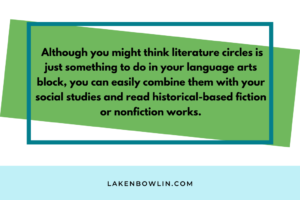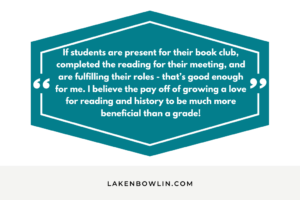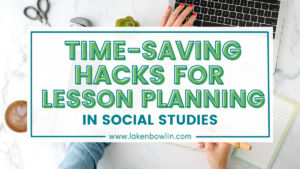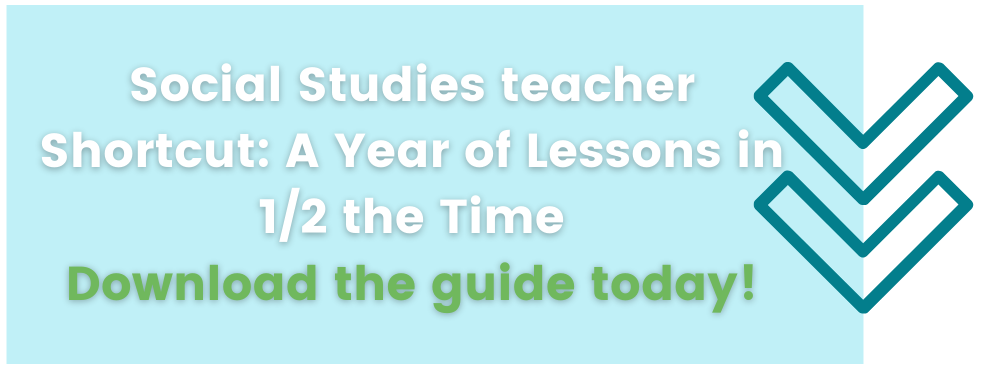 Put together a book club for elementary students to create a more engaging social studies classroom. Developing life-long readers means that we as teachers provide our students with ample opportunity to read engaging works. So why not combine history with your reading time and host a history book club? Read on for ideas on how you can implement one yourself.
Put together a book club for elementary students to create a more engaging social studies classroom. Developing life-long readers means that we as teachers provide our students with ample opportunity to read engaging works. So why not combine history with your reading time and host a history book club? Read on for ideas on how you can implement one yourself.
Are you looking for planning resources that are easy to use, minimal prep, and ready at your fingertips? I have created a planning document for upper-elementary social studies teachers, and you are definitely going to want to go check it out! I have pacing, linked resource ideas, vocabulary, and essential questions ready to go for you. If you teach in the upper elementary classroom, there is something for you in that document. What are you waiting for? Go check it out HERE!
How do I organize the book clubs for elementary students?
There are a couple of options you can try if you’re just starting book clubs. You might first try having a class book club set up, so students can see how discussions work. You can model what you’re thinking as you read a passage. This might also be a good fit if you have young students or if you need to differentiate for students with lower reading levels.
Alternatively, you can sort students into literature circles. If you haven’t used these already, you should definitely consider it! I love how they give independence and ownership back to the students. And although you might think literature circles is just something to do in your language arts block, you can easily combine with your social studies and read historical-based fiction or nonfiction works.
If you are looking for other ELA activities to include in your social studies block, check out my blog on Teaching Vocabulary in the Social Studies Classroom!

What does a book club for elementary students look like?
There’s definitely prep work when you first get started, but if you incorporate book club cycles often in your classroom your students will begin to pick up expectations. Vet your books and make sure you suggest varying reading levels and lengths – you might not always want lengthy chapter books. You also need to consider if you’re looking to focus on a specific time period or event or if you’re just looking for students to be emersed in historical writing. My personal favorite is hosting one round of book clubs per unit and then centering a selection of books based on that topic!
Each student should have a responsibility. You can find a number of options for book club jobs for students, but you want each student to have ownership in getting the reading done. Assign students to different jobs, like tracking the reading, making sure everyone has a turn to share, taking notes from discussions, reading discussion questions, etc. You can find lots of resources for class book club ideas and elementary book club activities on Teachers Pay Teachers!
You can have any type of assessment at the end. Students can turn in their discussion notes, or you can sit with each group for a final chat on their book. You can put together creative assessments that the students complete as a group and present to the class. You can have them create a commercial for the book to persuade someone else to read it as well. Students can also simply rate books when they are done, which you can use to facilitate the next cycle of book clubs as students decide what they would most like to read.
How do I evaluate book clubs in the classroom?
I wish I could say we read for the sake of reading, but we all know that’s not how classrooms work. I still wouldn’t recommend having a grade for book club time. Consider instead counting it towards participation, with a possible creative project at the end if you feel like you need an assessment activity. If students are present for their book club, completed the reading for their meeting, and are fulfilling their roles – that’s good enough for me. I believe the pay off of growing a love for reading and history to be much more beneficial than a grade!

If you’d like a list to get started with a premade book list, check out my Read Alouds for Upper Elementary Social Studies list here. There are several read-aloud books that can work for book clubs, or you can ask your librarian and media specialists for their favorite picks!
Let me know in the comments below what you love about book clubs for elementary students or your favorite activities you implement to incorporate historical books into your classroom.
Did you miss it? It’s okay, I got you! I know you are overwhelmed with planning engaging lessons across all your subjects, so don’t make social studies become another pain point for you. Download your Social Studies Teacher Shortcut: A Year of Lessons in ½ the Time to get all your planning organized and in one place.

Related Articles
Facilitating a Big History Book Club for Students
How to Run a Full-Choice Book Club in Your Classroom: Independent Reading in Secondary (Much of this applies to upper elementary too!)








